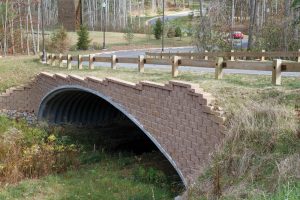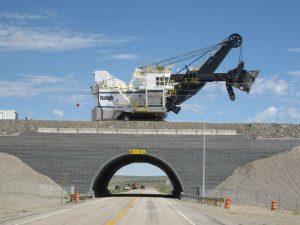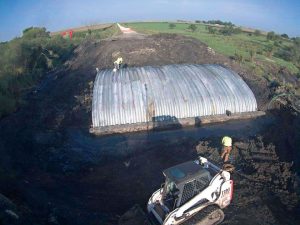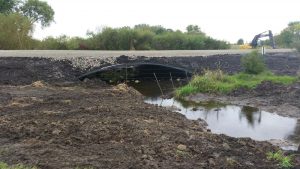A Nontraditional Approach to Rebuilding the Nation’s Bridge Infrastructure
It is no secret the U.S. infrastructure needs an overhaul. The American Society of Civil Engineers (ASCE) 2017 Infrastructure Report Card gives the nation’s infrastructure an overall grade of D+.
The subcategory of bridge infrastructure fares a bit better, earning a C+ grade, which is unchanged from the previous report card issued four years ago. More than 56,000 of the nation’s bridges were structurally deficient in 2016, and the most recent estimate for the backlog of bridge rehabilitation needs is $123 billion. (Read more at http://bit.ly/2E7GTfM).
Over half of these bridges are owned by cities and counties, and are typically comprised of short-span bridges with spans under 140 feet in length. While the aging bridge inventory and the increased need for repair and replacement are documented and widely acknowledged, the resources for funding continue to lag behind, forcing local, state, and federal Department of Transportation engineers to explore alternatives to traditional bridge replacement options. One of those alternative designs can be found underground (Figure 1).
An Economical Solution
Eighty years ago, structural-plate buried structures – also referred to as steel buried bridges – were used as a more robust alternative to traditional culverts for use in hydraulic and minor crossings. They were primarily used where culverts could not meet flow and size requirements or where bottomless structures were needed. Structural-plate buried structures have evolved over the years with industry advancements in design and analysis tools, as well as deeper corrugation profiles that allow for longer spans, heavier loads, and higher cover. They are now a viable design option in almost all cases where a traditional bridge is used and should be considered with other options such as modular, beam, or truss bridges. Almost every small- to medium-span bridge application could likely allow for a buried bridge solution. They are particularly useful in the 25-foot to 80-foot span range.
A structural-plate buried bridge consists of a series of rings. A ring is one set of plates used to form the shape of the bridge. The standard plate width is 30 inches, and it typically takes three or more plates to form the bridge shape depending on the span and rise of the bridge. The plate sections can be assembled on site, placed on the footing, and then attached one ring at a time or one plate at a time. The assembly sequence varies based on the structure size, site conditions, and contractor’s equipment and experience (Figure 2).
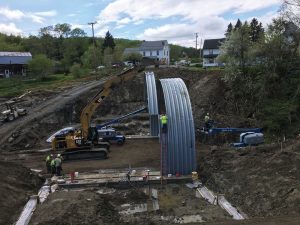
Figure 2. Plates being assembled on the Route 2B Bridge replacement project in
St. Johnsbury, Vermont.
These types of bridges carry loads through soil-structure interaction, so the bridge structure and the backfill soils surrounding it interact with each other to support the loads. In effect, the backfill material is part of the bridge. Because of this interaction, the bridge structure is typically lighter than other types of bridge structures and there can be significant savings in structure costs.
Structural-plate buried bridges do not require abutments and, unless foundation soil conditions are very poor, do not typically require deep foundations. They can be tailored to site conditions and geometry requirements, and their design includes inputs for site soils and backfill. Locally available materials can often be used in construction.
While they can perform similar functions to a culvert, buried bridge structures usually do not have an invert, have much larger corrugation profiles, and are designed and built for much longer spans. Buried bridges have a longer service life, greater steel thickness, and a 50 percent greater galvanized coating than that of culverts.
The design benefits of a structural-plate buried bridge include:
- Accelerated bridge construction (ABC) practices (almost all structural-plate buried bridge projects are ABC projects),
- Lower installed costs compared to traditional bridges and rigid structures,
- The ability to carry very heavy loads,
- Increased resilience through redundant systems and flexibility,
- Improved aesthetics through the use of a wide variety of end treatments,
- Ease in shipment, as the steel plates stack easily and, in most cases, can be transported to remote sites with limited access one plate at a time on a small truck or other light off-road vehicles if needed,
- Easy assembly using local crews, with little to no experience, and light equipment already being used at the site such as skid steer loaders, forklift trucks, and backhoes, and
- Lower maintenance and inspection costs than other types of bridge structures.
One of the most significant benefits of structural-plate buried bridges is their ability to support very heavy loads. Because of soil-structure interaction, they can be designed to carry mining shovels and other equipment weighing over four million pounds, large off-road trucks weighing over one million pounds, and freight train loads (Figure 3).
Another benefit is lead time on design and material acquisition, which is often accelerated because the structure is frequently designed by the time the project is awarded. Approval drawings can be prepared very quickly and, in many cases, it can take just weeks to go from a signed contract to having a product on site. Many buried bridges can be built in two days or less, excluding foundation work.
A Low-Cost, Easy-to-Build Example
The 200th Street Bridge is located about 3.5 miles outside of Jesup, Iowa, in Buchanan County, a rural area that relies heavily on agriculture. Built in 1956, the original timber piling for the 32-foot-long by 20-foot-wide, two-span bridge – a timber stringer/multi-beam or girder – was deteriorating and had a weight-limit posted, which limited the types of farm equipment and trucks that could cross over it.
Faced with a backlog of bridges needing repair or replacement and limited funds, the Buchanan County engineer had several challenges to consider when making a decision for this particular project. He needed a structure that could meet the required HL93 design loading for interstate highways to accommodate heavy grain and livestock trucks and farm equipment. The design had to consider tight schedule constraints, poor site foundation soil conditions, and less-than ideal-granular backfill. Also, to keep costs down, he wanted to use a local crew.
Taking all factors into consideration, the Buchanan County engineer and project designer/fabricator agreed on a structural-plate buried bridge as the most economical and time-saving solution. A local firm, Zieser Construction, was chosen as the contractor.
The original 200th Street Bridge was demolished in June 2015 and construction on the new bridge began in August. The new bridge was designed, fabricated, and delivered to the site in less than six weeks.
200th Street Bridge Project Details
The structure was designed in accordance with Section 12 of the American Association of State Highway and Transportation Officials’ (AASHTO) LRFD Bridge Design Specifications and constructed in accordance with Section 26 of the AASHTO LRFD Bridge Construction Specifications. The designer/fabricator used CANDE®, a finite element analysis program developed for the Federal Highway Administration for analyzing the soil-structure interaction of buried structures, to develop an optimized design. The structure geometry was customized to meet site constraints and hydraulic requirements, and the design considered properties of site soil conditions and available backfill materials. The bridge was sized to accommodate site hydraulic requirements. The existing soft, mucky soil required the new buried bridge structure to be supported by H-pile foundations.
The optimized design for this project saved time and costs compared to more traditional “canned” precast structures. Corrugation profile and steel properties provide design flexibility for bridge spans and loadings comparable to or greater than similar-sized precast or cast-in-place concrete structures. Because a structural-plate buried bridge design was selected, it was possible to increase the effective roadway width with minimal additional cost. This allowed for significant safety improvements, such as two lanes of traffic plus room for oversized vehicles or pedestrians.
The bridge was constructed of deep corrugated galvanized steel plate with a corrugation profile of 15 inches wide (peak-to-peak) and 5.5 inches deep (peak-to-valley). The steel thickness was 0.315 inches (0 gauge) with a bolt spacing of 16 inches center-to-center on the neutral axis around the periphery. The completed structure required 18 rings for a final length (bridge width) of 45 feet.
The four-person crew from Zieser Construction had never worked on a structural-plate buried bridge project before but found it an easy process that did not require special skills or equipment. They used a hydraulic excavator for this project. Typically, the equipment needed for a structural-plate buried bridge project of this size in this setting include a backhoe, an air compressor to operate impact wrenches for bolting, and a skid loader or forklift truck to help with staging of the plates at the site (Figure 4).
The 200th Street Bridge replacement was completed in September 2015. It is a 39-foot, 4-inch long single span by 8-foot, 2-inch rise by 45-foot-wide galvanized structural-plate buried bridge, allowing access by all farm equipment and trucks in the area (Figure 5). The installed cost for the bridge was $95,000. In comparison, a let bridge would have cost about $156,000, a significant savings for a limited budget.
Long-Term Maintenance Benefits
Galvanized structural-plate buried bridges require less maintenance than any other type of bridge system. At the pavement level, there are no bridge deck or joints to clean, maintain, or replace. On the underside, general maintenance consists of removing undesired vegetation and possible cleaning depending on silting or debris, similar to other types of bridges.
Additionally, there is little differential movement or settlement between the buried bridge and adjacent embankments, so the “bump at the end of the bridge” that occurs with traditional bridges and precast structures is effectively eliminated. Due to the soil backfill, differential icing compared to approach embankments is not an issue, improving safety during winter months and translating to lower inspection and maintenance costs.
For the 200th Street Bridge, the only anticipated maintenance is blading the traveled surface and preventing trees from growing in the channel.
With the success of the 200th Street Bridge project, the Buchanan County engineer is planning to construct additional structural-plate buried bridges. In addition to the many design and construction advantages, the compact structures can be easily stored in the yard or at the site and built when the schedule permits, providing additional time to meet tight schedules.
New Design Tool is Available
The Short Span Steel Bridge Alliance has developed a free, web-based design tool – eSPAN140 (accessible at www.espan140.com) – to create customized preliminary designs for rolled beam, plate girder, corrugated structural plate, and corrugated steel pipe short span bridges. Only three basic inputs are required.
A Smart Choice for Repairing the Nation’s Bridge Infrastructure
Bridge design professionals across the country are looking for economical, efficient solutions to meet their growing backlog of projects. Structural-plate buried bridges provide viable solutions to many of these challenges. When planning a bridge replacement project, structural-plate buried bridges should be considered as an option.▪

